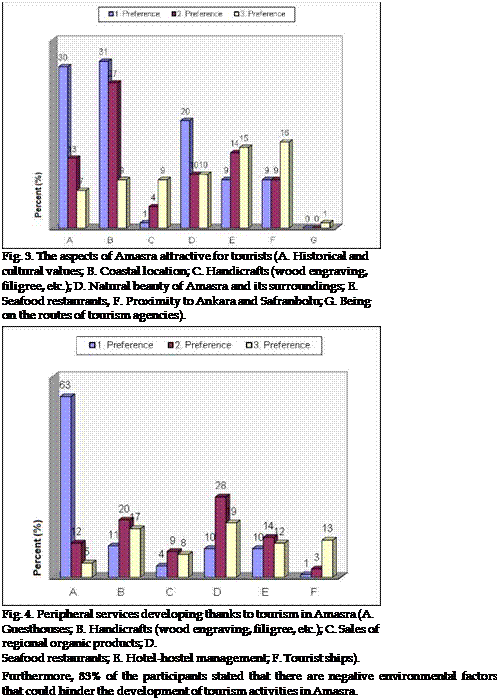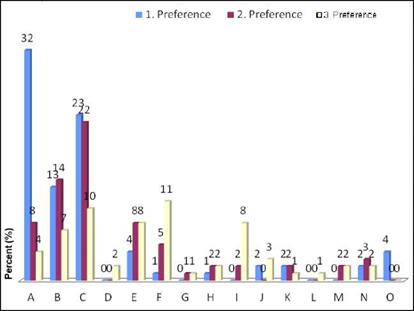Among the participants whose source of income is tourism, 15% are engaged in running guesthouses, 9% in handicrafts (wood engraving, filigree, etc.), and 8% are restaurateurs (Table 4).
|
Percent (%) |
||
|
Occupation of local residents whose source of income is tourism |
No response |
62 |
|
Guesthouse management |
15 |
|
|
Handicrafts (wood engraving, filigree, etc.) |
9 |
|
|
Restaurateurs |
8 |
|
|
Hotel management |
2 |
|
|
Other |
4 |
|
Table 4. Occupation of local residents whose source of income is tourism. |
Amongst the primary problems faced by the participants whose source of income is tourism, the first was lack of training in tourism (13%), followed by lack of standards in the tourism sector and lack of awareness among the public about tourism (both 6%) (Figure 2).
|
Fig. 2. Primary problems faced by participants with tourism as source of income (A. Financial difficulties; B. Lack of education in tourism; C. Limitations due to Amasra’s status as a protection site; D. Lack of attention from local administrations; E. Lack of standards in the tourism sector; F. Lack of branding; G. Lack of local residents’ awareness regarding tourism; H. Other). |
The participants indicated that the busiest months of tourism activities in Amasra are July (74%), August (61%), and June (43%).
According to the participants, the tourist demand for Amasra is due to its coastal location (31%), the historical and cultural values (30%) and natural beauty of the town and its surroundings (20%). In addition, the analysis of the ranking of the first, second and third preferences belonging to the same option revealed that the choice ”seafood restaurants" is of prominence with values close to each other in all the three preferences of the participants (Figure 3).
86% of the participants stated that the tourism potential of Amasra is not sufficiently utilized, in constrast with 13% of the participants who thought it was sufficiently used. 1% of the participants did not answer this question.
In terms of peripheral services developing thanks to tourism, 63% of the participants ranked guesthouses as the first choice, 28% handicrafts and 19% seafood restaurants (Figure 4).
54% of the participants stated that the impact of tourism in Amasra are positive, while 7% considered the impact negative and 39% both positive and negative. Among the participants who indicated that the impact is positive, 44% thought that it is effective in the promotion of the town. According to the participants, the negative impact of tourism is due to, first, the degradation of traditional houses because of unplanned development; second, the number of visitors exceeding the carrying capacity, and third, degradation of natural and cultural areas, and visual pollution (Table 5).

|
I. Preference |
II. Preference |
III. Preference |
||
|
Percent (%) |
||||
|
Positive impact of tourism in Amasra |
No response |
7 |
43 |
67 |
|
Creating comfortable environments with landscape design |
7 |
4 |
4 |
|
|
Promotion of Amasra |
44 |
15 |
5 |
|
|
Protection of cultural heritage |
2 |
16 |
9 |
|
|
Economic contribution to Amasra |
40 |
18 |
9 |
|
|
Ensuring the continuity of handicrafts |
– |
4 |
6 |
|
|
Other |
– |
– |
– |
|
|
Negative impact of tourism in Amasra |
No response |
52 |
69 |
73 |
|
Change in local culture and traditional social structure |
8 |
1 |
1 |
|
|
Degradation of traditional houses due to unplanned development |
15 |
5 |
4 |
|
|
Degradation of natural and cultural areas due to the number of visitors exceeding the carrying capacity |
4 |
9 |
1 |
|
|
Degradation of the peninsula landscape and vegetation |
3 |
4 |
2 |
|
|
Air pollution |
– |
1 |
– |
|
|
Coast and sea pollution |
8 |
8 |
4 |
|
|
Soil pollution |
– |
– |
2 |
|
|
Visual pollution |
4 |
3 |
8 |
|
|
Noise pollution |
2 |
– |
5 |
|
|
Other |
4 |
– |
– |
|
Table 5. Local residents’ perspective on the impact of tourism in Amasra. |
The negative environmental factors that hinder the development of tourism activities were listed as some buildings with historical features in a state of neglect (32%), parking problems (23%), and unplanned and dense urbanization (13%) (Figure 5).
|
Fig. 5. Negative environmental factors that hinder the development of tourism activities in Amasra. (A. Some buildings with historical features in a state of neglect; B. Unplanned and dense urbanization; C. Parking problems; D. Sewerage; E. Visual pollution; F. Coastal and marine pollution; G. Air pollution; H. Overcrowding and noise; I. Degradation of the nature due to summer houses; J. Degradation of the nature due to road construction works; K. Difficulties in transport; L. Soil pollution; M. Problems due to physical planning and practice; N. Environmental problems caused by Turkish Hard Coal Authority; O. Other). |
According to the participants, the forms of tourism that could be developed in Amasta are cultural tourism (61%), sea tourism (17%), and ecotourism (12%) (Table 6).
|
I. Preference |
II. Preference |
III. Preference |
||
|
Percent (%) |
||||
|
Forms of tourism that could be developed in Amasra |
No response |
3 |
29 |
56 |
|
Cultural tourism |
61 |
7 |
– |
|
|
Culinary tourism |
4 |
4 |
2 |
|
|
Rural tourism |
3 |
5 |
5 |
|
|
Sea tourism |
17 |
23 |
9 |
|
|
Nature tourism |
12 |
31 |
27 |
|
|
Other |
– |
1 |
1 |
|
Table 6. Local residents’ perspectives on the forms of tourism that could be developed in Amasra. |





